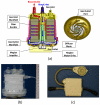A novel wearable pump-lung device: in vitro and acute in vivo study
- PMID: 22014451
- PMCID: PMC3237773
- DOI: 10.1016/j.healun.2011.08.022
A novel wearable pump-lung device: in vitro and acute in vivo study
Abstract
Background: To provide long-term ambulatory cardiopulmonary and respiratory support for adult patients, a novel wearable artificial pump-lung device has been developed. The design features and in vitro and acute in vivo performance of this device are reported.
Methods: This device features a uniquely designed hollow-fiber membrane bundle integrated with a magnetically levitated impeller that together form one ultracompact pump-lung device, which can be placed like current paracorporeal ventricular assist devices to allow ambulatory support. The device is 117 mm in length and 89 mm in diameter and has a priming volume of 115 ml. In vitro hydrodynamic, gas transfer and biocompatibility experiments were carried out in mock flow-loops using ovine blood. Acute in vivo characterization was conducted in an ovine model by surgically implanting the device between right atrium and pulmonary artery.
Results: The in vitro results show that the device with a membrane surface area of 0.8 m(2) was capable of pumping blood from 1 to 4 liters/min against a wide range of pressures and transferring oxygen at a rate of up to 180 ml/min at a blood flow of 3.5 liters/min. Standard hemolysis tests demonstrated low hemolysis at the targeted operating condition. The acute in vivo results also confirmed that the device can provide sufficient oxygen transfer with excellent biocompatibility.
Conclusions: Based on in vitro and acute in vivo study findings, this highly integrated wearable pump-lung device can provide efficient respiratory support with good biocompatibility and it is ready for long-term evaluation.
Copyright © 2012 International Society for Heart and Lung Transplantation. All rights reserved.
Figures




Similar articles
-
In vitro and in vivo evaluation of a novel integrated wearable artificial lung.J Heart Lung Transplant. 2017 Jul;36(7):806-811. doi: 10.1016/j.healun.2017.02.025. Epub 2017 Mar 4. J Heart Lung Transplant. 2017. PMID: 28359655 Free PMC article.
-
Thirty-day in-vivo performance of a wearable artificial pump-lung for ambulatory respiratory support.Ann Thorac Surg. 2012 Jan;93(1):274-81. doi: 10.1016/j.athoracsur.2011.08.076. Epub 2011 Nov 25. Ann Thorac Surg. 2012. PMID: 22115337 Free PMC article.
-
Computational design and in vitro characterization of an integrated maglev pump-oxygenator.Artif Organs. 2009 Oct;33(10):805-17. doi: 10.1111/j.1525-1594.2009.00807.x. Epub 2009 Jul 22. Artif Organs. 2009. PMID: 19681842
-
Functional and biocompatibility performances of an integrated Maglev pump-oxygenator.Artif Organs. 2009 Jan;33(1):36-45. doi: 10.1111/j.1525-1594.2008.00672.x. Artif Organs. 2009. PMID: 19178439
-
Cardiac extracorporeal life support: state of the art in 2007.Cardiol Young. 2007 Sep;17 Suppl 2:104-15. doi: 10.1017/S1047951107001217. Cardiol Young. 2007. PMID: 18039404 Review.
Cited by
-
Biocompatibility assessment of a long-term wearable artificial pump-lung in sheep.Artif Organs. 2013 Aug;37(8):678-88. doi: 10.1111/aor.12049. Epub 2013 Mar 3. Artif Organs. 2013. PMID: 23452221 Free PMC article.
-
Right ventricular unloading and respiratory support with a wearable artificial pump-lung in an ovine model.J Heart Lung Transplant. 2014 Aug;33(8):857-63. doi: 10.1016/j.healun.2014.02.026. Epub 2014 Feb 26. J Heart Lung Transplant. 2014. PMID: 24746636 Free PMC article.
-
In vitro and in vivo evaluation of a novel integrated wearable artificial lung.J Heart Lung Transplant. 2017 Jul;36(7):806-811. doi: 10.1016/j.healun.2017.02.025. Epub 2017 Mar 4. J Heart Lung Transplant. 2017. PMID: 28359655 Free PMC article.
-
Darcy Permeability of Hollow Fiber Membrane Bundles Made from Membrana Polymethylpentene Fibers Used in Respiratory Assist Devices.ASAIO J. 2016 May-Jun;62(3):329-31. doi: 10.1097/MAT.0000000000000348. ASAIO J. 2016. PMID: 26809086 Free PMC article.
-
In Vitro Characterization of the Pittsburgh Pediatric Ambulatory Lung.ASAIO J. 2018 Nov/Dec;64(6):806-811. doi: 10.1097/MAT.0000000000000711. ASAIO J. 2018. PMID: 29240630 Free PMC article.
References
-
- American Lung Association [Accessed on July, 2011];Lung Disease Data. 2008 http://www.lungusa.org/about-us/publications/
-
- Christie JD, Edwards LB, Kucheryavaya AY, et al. The Registry of the International Society for Heart and Lung Transplantation: twenty-seventh official adult lung and heart-lung transplant report--2010. J Heart Lung Transplant. 2010;29(10):1104–18. - PubMed
-
- Aziz TA, Singh G, Popjes E, et al. Initial experience with CentriMag extracorporal membrane oxygenation for support of critically ill patients with refractory cardiogenic shock. J Heart Lung Transplant. 2010;29(1):66–71. - PubMed
-
- Camboni D, Philipp A, Haneya A, et al. Serial use of an interventional lung assist device and a ventricular assist device. ASAIO J. 2010;56(3):270–2. - PubMed
-
- Griffith KE, Jenkins E, Haft J. Treatment of massive pulmonary embolism utilizing a multidisciplinary approach: a case study. Perfusion. 2009;24(3):169–72. - PubMed
Publication types
MeSH terms
Grants and funding
LinkOut - more resources
Full Text Sources
Other Literature Sources
Medical

